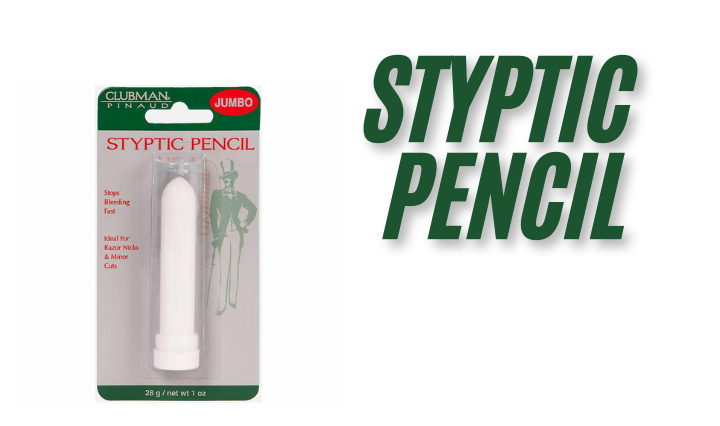Introduction
Ever found yourself in a bit of a bind after a quick trim or a close shave? You’re not alone! Picture this: you’re having a fine day, looking to give yourself a little grooming boost, but bam! A tiny nick turns into a not-so-tiny disaster. It’s enough to make anyone’s heart race, but fear not—this is where the styptic pencil swoops in to save the day! In this article, we’ll dive deep into the world of styptic pencils, exploring what they are, how they work, and why they deserve a place in your grooming kit. Let’s get started!
What is a Styptic Pencil?
At its core, a styptic pencil is a small, unassuming tool designed to stop bleeding. Primarily used in shaving and minor cuts, this nifty little pencil has been a go-to solution for barbers and DIY groomers alike. Made from an astringent compound—typically aluminum sulfate—the styptic pencil constricts blood vessels, sealing off the wound and promoting quick healing.
A Brief History of the Styptic Pencil
You might be wondering, how did this little lifesaver come to be? Here’s a quick snapshot:
- Ancient Roots: The concept of a styptic agent dates back thousands of years, with ancient civilizations utilizing various methods to control bleeding.
- Modern Development: The styptic pencil, as we know it today, gained popularity in the early 20th century. It became a staple for barbers and men’s grooming kits.
- Versatile Uses: Over the years, its uses expanded beyond just shaving cuts, becoming essential for anyone engaged in activities that might lead to minor injuries.
How Does a Styptic Pencil Work?
Let’s break it down!
- Astringent Action: When you apply a styptic pencil to a cut, the aluminum sulfate causes the tissue to contract, which helps to stem the flow of blood.
- Sealing the Wound: This contraction seals the wound, acting as a barrier and preventing further bleeding.
- Promoting Healing: Besides stopping the bleeding, the pencil helps to dry up the area, which can speed up the healing process.
Applying a Styptic Pencil: Step-by-Step Guide
Using a styptic pencil is super simple! Follow these steps the next time you find yourself in a pinch:
- Clean the Area: Start by cleaning the cut with soap and water to reduce the risk of infection.
- Wet the Pencil: Dampen the tip of the styptic pencil with water. This helps it adhere better to the skin.
- Apply Firmly: Press the pencil against the cut for about 10-15 seconds. You might feel a slight sting—this is normal!
- Rinse and Repeat: Once the bleeding stops, you can rinse off any excess powder, but don’t overdo it. Let the area breathe!
Why Every Groomer Needs a Styptic Pencil
Alright, let’s get real here. Why should you bother adding a styptic pencil to your grooming arsenal? Here are a few compelling reasons:
Quick Fix for Minor Cuts
- Instant Relief: No one likes to see blood when they’re trying to look sharp. A styptic pencill offers immediate action, letting you get back to your routine without fuss.
Portable and Convenient
- Travel-Friendly: Styptic pencils are small and lightweight, making them perfect for your travel kit. Whether you’re heading to the gym or going on a trip, you can easily toss one in your bag.
Affordable Solution
- Cost-Effective: You don’t have to break the bank to keep one of these around. A single styptic pencill can last you ages, making it a smart investment for your grooming needs.
Multi-Purpose Tool
- Beyond Shaving: While it’s primarily known for stopping shaving nicks, you can use it for minor cuts while cooking or even during hobbies like woodworking.
Styptic Pencil Alternatives: What to Use in a Pinch
You might be thinking, “What if I don’t have a styptic pencill on hand?” Don’t sweat it! Here are some alternatives you can reach for in a pinch:
- Cornstarch or Flour: These can help absorb moisture and promote clotting.
- Baking Soda: A natural astringent that can help stop bleeding when pressed against a cut.
- Tea Bags: The tannins in black tea can aid in clotting. Just wet and press against the wound!
FAQs About Styptic Pencils
How long does a styptic pencil last?
Typically, a styptic pencil can last for several months to even years, depending on how often you use it. Just keep it dry and store it in a cool place!
Can I use a styptic pencil on my face?
Absolutely! A styptic pencill is designed for small cuts and nicks, making it perfect for facial grooming. Just be careful around sensitive areas!
Are there any side effects?
Most people won’t experience side effects, but a mild stinging sensation is common upon application. If you notice severe irritation or allergic reactions, stop using it immediately.
Is a styptic pencil safe for pets?
It’s best to avoid using a styptic pencill on pets without consulting a veterinarian first. There are pet-specific products designed for minor cuts and scrapes.
How do I store my styptic pencil?
Keep your styptic pencill in a cool, dry place, away from moisture. This ensures it stays effective for as long as possible!
Conclusion
So there you have it! The styptic pencill is more than just a humble grooming tool—it’s a small yet mighty ally in the face of minor cuts and scrapes. With its rich history, ease of use, and affordability, there’s no reason not to have one (or two!) in your grooming kit.


